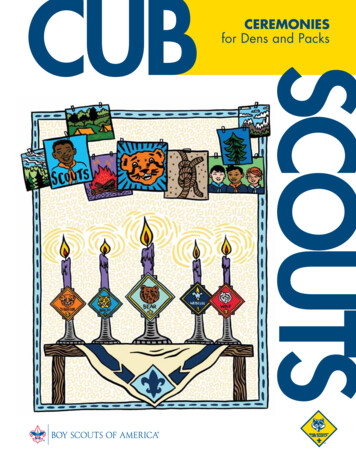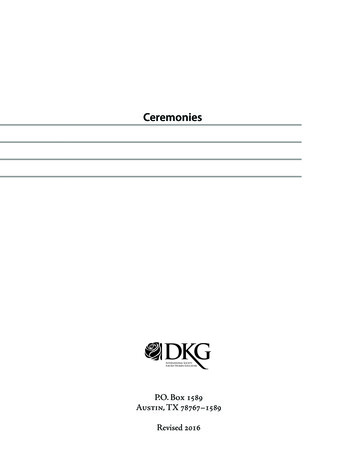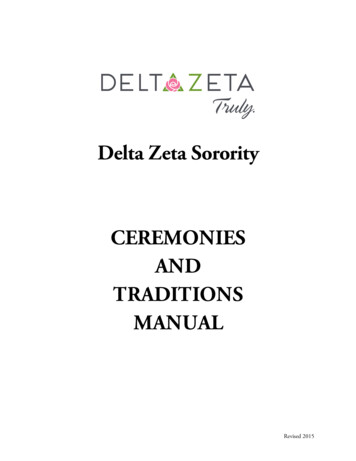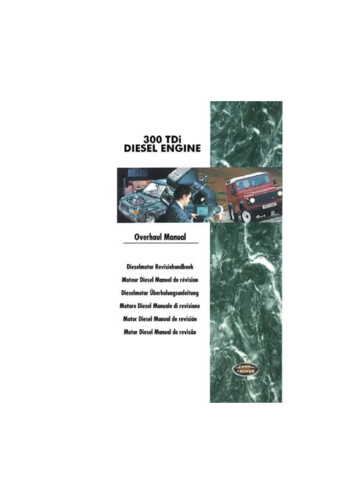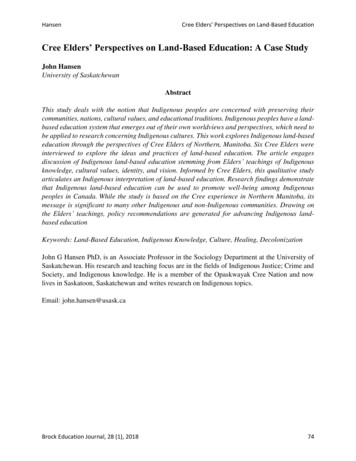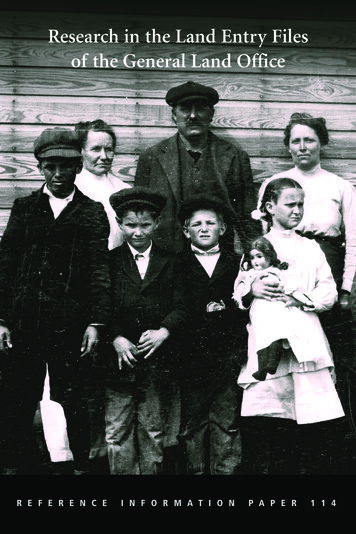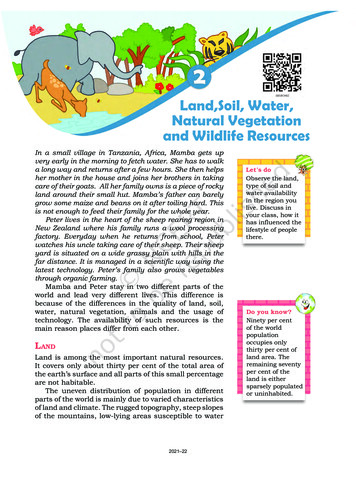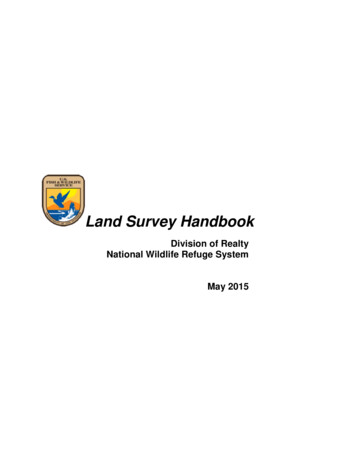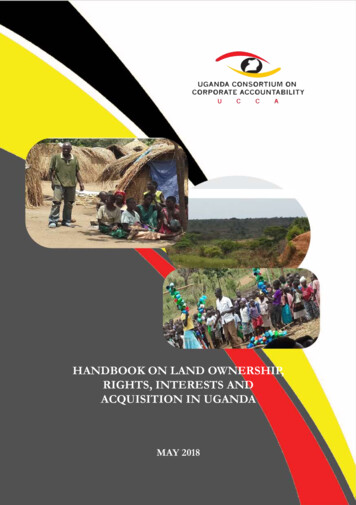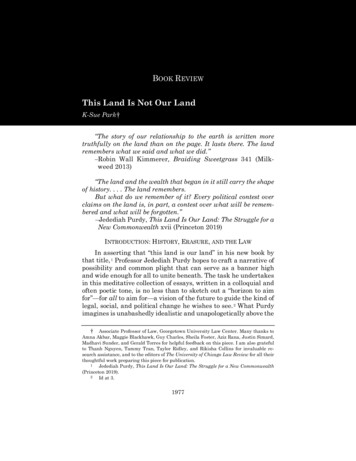
Transcription
SESSION3The Land Is UsEn’owkin CentreLand contains the languages, the stories, and the histories of the people. It provides water, air, shelter, and food.Land participates in the ceremonies and songs. And land is home. —Thomas King 1The En'owkin Centre, which is located on the Penticton Indian Reserve. The En'owkin has a unique and diverse eco landscape surrounding theexterior of the facility.Land plays a central role in the worldviews ofmost Indigenous Peoples of Turtle Island. Land,however, is not understood as a piece of dirt,as real estate, as property, or as a resource. Theanimals, the plants, the mountains, the hills, andthe rivers are a community to which one belongs.Places are often associated with stories, meaningthat the land is a teacher and the wellspring ofmeaning. To be separated from one’s land, one’sterritory, then, is to be separated from one’sculture, spirituality, and sense of self.The Land Is UsBy Jeannette Armstrong 2The land that I come from is very dry and semiarid. It’s considered the northern tip of the GreatBasin Desert and the ecosystem there is very, veryfragile. At this time, the Okanagan is one of the mostdamaged areas and ecosystems in Canada becauseof its fragility. In our area many conservationists andenvironmentalists are very concerned about the speciesthat are endangered and disappearing there. We live inan area where extirpations have been happening overthe last one hundred years; I’ve seen some of thoseextirpations myself.This has been difficult because we grew uploving the land. We grew up loving each otheron the land and loving each plant and eachspecies the way we love our brothers andsisters and that’s the point I want to get across.28
SESSION3That doesn’t just happen as an intellectual process.That doesn’t just happen as a process of needing togather food and needing to sustain our bodies forhealth. It happens as a result of how we interact witheach other in our families , in our extended family units,and in our communities; the networks that we makeoutward to other people who surround us on the land.Those networks are extremely important insofar as whathappens to the land and how we interact with the land.My body is the landIn the Okanagan, our understanding of theland is that it’s not just that we’re part of theland, it’s not just that we’re part of the vastsystem that operates on the land, but that theland is us. In our language, the word for ourbodies contains the word for land,so when I say that word, it means that not onlyis my ability to think and to dream present inthat word but the last part of that word alsomeans “the land.”In the most basic sense, our use of the land relatesto our need for food, for shelter, for clothing, andbeyond . There are things that we need to live andbreathe every day. But beside that we need pleasure.We need to be loved and we need to have the supportof our community and the love that people surroundingus can give us. If we think about how those two thingsare combined together and work together, if those twoideas and ideals can work together, then we can see howwe can either impact the land in a negative way or in apositive way.If I look around at how the land has beenimpacted by what I call the Western culture,one of the things I see is an overuse ofresources by some people and a lack of accessto those same resources for others .There are some people who cannot access even themost basic things that they need.Thus, in my mind, every time I say that wordand I refer to myself, I realize that I am fromthe land. I’m saying that I’m from the landand that my body is the land .I go out to the land to gather the foods thathave given me life, and given my grandmotherslife, and given my great-great-grandmotherslife for many, many generations. When we goout to the land, our people have perfecteda way of interacting with each other that isrespectful to the land and respectful to eachother but also fulfills some needs that wehave that are human in terms of interactionand relationship to one another.What our grandparents have said isthat the land feeds us, but we feedthe land as well.What they meant by that was that we give ourbodies back to the land in a very physical way,but we also do other things to the land. Welive on the land and we use the land and, in sodoing, we impact the land: we can destroy it,or we can love the land and it can love us back.Healing Herbs, Diane Montreuil.29
SESSIONThe Land Is UsWhen you look at the idea of democracy from thatperspective, you can see there’s something profoundlywrong with a hierarchical system in which people sittingnext to you or next door to you don’t have access tothe same things you do. That seems to me to be aprofoundly basic communal principle: Everyone in acommunity needs to have the same access to the basicsand the same access to the joys and pleasures of life .Speaking for the landWhen we approach the decision-making process, we are different than other communities in that wehave different people, trained as part of the familysystem, to be speakers for the children, for themothers, for the Elders, for the medicine people, forthe land, for the water .My part has been to be trained by my Elders to thinkabout the land and to speak about the land . Eachtime a decision is made, even the smallest decision, myresponsibility is to stand up and ask,How will it impact the land? How is it going toimpact our food? How is it going to impact ourwater? How is it going to impact my children,my grandchildren, my great-grandchildren:what’s the land going to look like in their time?The realization that people and community are thereto sustain you creates the most secure feeling in theworld. When you feel that and you’re immersed in that,then the fear starts to leave. When that happens, you’reimbued with the hope that others surrounding you inyour community can provide . I’m talking about allof the people who live in the Okanagan and peoplewho we reach outside of that. Not just the IndigenousPeople, because at this time in our lives, our Elders havesaid that unless we can “Okanaganize” those peoplein their thinking, we’re all in danger in the Okanagan.It sounds very simple and yet it seems to be anoverwhelming task .The last thing that I want to share with you is somethingthat makes a lot of sense to me and that is my father’swords for insanity. For us it means that too many peopleare talking about different things rather than peopletalking about the same thing. There does seem to beinsanity in the world because of what’s missing inside interms of our humanity with each other. When we start totake care of that, everything else will naturally follow.30A Source of Belongingor Belongings?By Robin Wall Kimmerer 3Two worldviews met on this continent,worldviews which colour our relationswith the living land, which shape ouranswer to the question “What does land mean?”A worldview in which land was understoodas sacred, as our sustainer, our pharmacy,our identity, our home, our library—the placewhere we play out our moral responsibilityin return for our very lives peopled with ournon-human relatives: This is a way of being inwhich the tar sands are unthinkable.This view of the Earth suddenly encounteredanother view, a kind of climate change invalues. The whole notion of land as a set ofrelationships and moral responsibilities wasreplaced by the notion of land as rights: rightsto land as property.And what our people called the gifts of theland suddenly became natural resources,ecosystem services, and capital. Nature asfamily became nature as machine and ournon-human relatives, our teachers, becamemere objects for consumption. This is a way ofbeing that invites us to the tar sands.This is the same question that hasus teetering on the precipice ofunparalleled extinction and climatechaos: Is the land a source ofbelongings or a source of belonging?Robin Wall Kimmerer is a professor ofEnvironmental Science and Forestry at theState University of New York (Syracuse),member of the Citizen Potawatomi Nation,and author of Braiding Sweetgrass. Adobe Stock3
SESSION3Reseeding the futureIn the work that we do, one of the things I’ve learned isthe power of taking our young people out to the landto gather seeds or to gather our Indigenous foods.We started a program to replant Indigenous plants torenew the imperilled habitat that we share with someendangered animal species; we’ve got about tenthousand plants going now.What we have found is that when we take the youngpeople out to restore the land, all kinds of communitymembers from the non-native community come outto participate, from multicultural societies or from thesenior people’s communities .One offshoot of this is that for the young people who arehaving such a difficult time (all young people are havinga difficult time), it heals them. The process of being withpeople, out there on the land, has a healing impact.Earth to Table Legacies/Deborah BarndtIt’s not just the work of collecting the seeds. Peoplewho are in farming know this: It’s not just the work ofcollecting but it’s being with people, the community,and communing with each other. It is how the landcommunes its spirit to you: it heals people and it doesthis in an incredibly profound way.We need to think about how we can do more of that.Jeannette Armstrong is a Syilx Okanagan author,artist, and environmental educator. She is the directorof the En’owkin International School of Writing andArts and a council member of the Okanagan Nation,British Columbia.“[Corn is ] a connection to our ancestorsbecause there are people who planted thatcorn for thousands and thousands of years,and had that connection with the earth andthat’s come to us today; similarly to howwe all have a belly button, we’re constantlyconnected to our mother, and their motherand their mother which goes back to theearth.” —Ryan DeCaire, Professor of MohawkLanguage, University of Toronto.431
SESSION3The Land Is UsA Haudenosaunee Greeting:Giving Thanks for OurRelationshipsBy John Mohawk 5This is the talk that our people give at the beginningand at the end of every group gathering, so thatwe remember our relationships. The point of thetalk is to remember that we are related to one another,related to the Earth, and related to all the things thatsupport life—and we are related to the universe, too. I’vealways thought it a very useful thing to remember thatrelationship requires us to be thankful:It is right when people come together that the firstthing they do is greet one another. It’s also true thatwe depend on our fraternity and sorority together, ourfriendships together. We acknowledge that we need32Sunrise Prayer, Diane Montreuil.one another, we who walk about on the earth. Weextend greetings and thanksgiving to each other, so beit our minds.We walk about on the Earth, she supports ourfeet, and we have been instructed that we willcall her our Mother, the Earth. It is good whenwe come together that we remember her, andwe think about what we owe her. We extendgreetings and thanksgiving to our Mother, theEarth, so be it our minds.We look about us and we see growing from the Earthalso the small grass life and herb life, thrush life. Weknow that from these things we get many things that weneed. We get fiber to make things with, medicines, andeven food. We need to put our minds to thinking about allthe herbs and thinking about all the grasses, to think about
SESSION3all the low-growing vegetable life that comes to us, andextend to them, the grass people, as we extend to people,our greetings and thanksgiving, so be it our minds.Owl’s Path MediaThere are others, too, as we walk about and see thewaters. We see many different kinds of water. The watersthat flow in small streams and the ones in great riversand the ones in great oceans, and we also see thatwater is very central to our life. About the first thing wedo in the morning when we get up is we use water towash ourselves with, we use it to cook with. We needthe water. Within our veins flows that water. We want toextend greetings and thanksgiving to the waters and allthe water life, so be it our minds.Sea King and Grizzly Bear, Tim Paul.There is another: As you look about, what grows withinour sight is the new tree life. The tree life also providesus with medicines, wood that keeps us warm, thingswe use to build our houses, but it does more than that.It also provides us with beauty, things that we can seeand appreciate about the world we live in. Among those,there’s a leader; in the world I come from it is the maplesyrup tree. We want to think about that tree, too. We putour minds together as one mind and extend greetingsand thanksgiving to all of the tree life and all of the spiritof the tree life in all of the world, so be it our minds.And there’s another. As we look up higher into the sky,we see those ones that fly about around us. When theycome north in the springtime, they bring us a good songand cheer. They always lift up our spirits. As we look atthem too, they know that they bring us knowledge andintelligence about the world that they have inhabitedfor so long. Let us think about all the bird life, especiallythat of the greatest birds—the eagles and the high-flyingbirds, too, the migratory birds. We extend greetings andthanksgiving to all the bird life, so be it our minds.As we walk upon the earth, we see that there are others:four-legged beings that are related to us, and thesefour-legged beings also exist in a way in the world thatbrings us delight and brings us good cheer of our minds.To all of the four-legged beasts and all of the animalsthat walk about on the earth, we extend greetingsand thanksgiving in the same spirit that we extend thegreetings and thanksgiving to others.And there’s another. As we look up higher into the sky wesee, also, that there is the one that walks across the sky inthe daytime and brings light. That’s the one that we callour elder brother, the sun. Let us think about that sun. It isthe one that represents the power of the universe. We putour minds together as one mind and extend greetings andthanksgiving to our brother, the sun.There’s a nighttime sun, that’s the grandmother moon,the one that also regulates the birth of everything on theearth, and we want to extend greetings and thanksgivingto our grandmother, the moon, so be it our minds.There’s another that each year comes from the West,what we call the thunder voices, and the thunder voicesare the ones that bring the winds and the weatherthat changes and cleanses the earth. We want toacknowledge that those spirits change and cleansethe earth. We put our minds together as one mind andextend greetings and thanksgiving to the thunder voices.There are the others. When we look up high in the sky,we can see that there are the stars that represent theface of the universe, unknowable to us, with knowledgethat we’ve already forgotten. We want to extendgreetings and thanksgiving to all of that, to all of theuniverse, to all the life of the universe, so be it our minds.Finally, there’s another. There’s a mystery about theuniverse, a plan that brought us and made all of thiscoherent, the intelligence that created everything. Wewant to think about that. We want to extend greetingsand thanksgiving to what they call the Great Creator,so be it our minds.John Mohawk was a respected teacher and farmerfrom the Turtle Clan of the Seneca (Onödowága,Haudenosaunee Confederacy) from Cattaraugus FirstNation, New York, who died in 2006.Find out more about the HaudenosauneeThanksgiving Address here: ltiv.ca/3/33
SESSION3The Land Is UsAcknowledging the LandBy âpihtawikosisân 6While acknowledging the land and the peoples who have traditionally inhabited a territory canserve a purpose, we must go well beyond a mere repetition of words.If we think of territorial acknowledgments as sites of potential disruption, they can betransformative acts that to some extent undo Indigenous erasure. I believe this is true as long as theseacknowledgments discomfit both those speaking and hearing the words. The fact of Indigenous presenceshould force non-Indigenous peoples to confront their own place on these lands. I would like to seeterritorial acknowledgments happening in spaces where they are currently absent .However, as we are already seeing,territorial acknowledgments can become stripped of their disruptive power through repetition.The purpose cannot merely be to inform an ignorant public that Indigenous peoples exist, and that Canadahas a history of colonialism .Moving beyond territorial acknowledgments means asking hard questions about what needs to be doneonce we’re ‘aware of Indigenous presence’.It requires that we remain uncomfortable, and it means making concrete, disruptive change.How can you be in good relationship with Indigenous peoples, with non-human beings, with the land and water?Writer and educator Chelsea Vowel (âpihtawikosisân) is Métis from manitow-sâkahikan (Lac Ste. Anne),Alberta, residing in amiskwacîwâskahikan (Edmonton).Find out more about land acknowledgements using the video resource from York University atltiv.ca/3/34
SESSION3ClassroommConnectionsSharing CircleSacred PlacesBefore beginning your groupdialogue, we suggest that you readout the Haudenosaunee Greeting, takingng turnsto read paragraphs as you move around the circle.1. What struck you most in this session?2. Describe a place in nature that is special too you. Howdo you feel when you are there? How might you feelif that place were lost or harmed?3. How would our ways of life change if we understoodland as “a source of belonging” rather than “asource of belongings”? “How can you be in goodrelationship with Indigenous Peoples, with nonhuman beings, with the land and water?”4. Share a quote, insight, or image that sticks with youas we conclude this session.What are some of the places that have beenconsidered of particular cultural or spiritualimportance for the Indigenous Peoples livingin your area?Divide into groups to research each siteidentified.Try to learn the traditional name(s) for eachsite identified.Find out about the stories associated withthis place and why it is significant.If possible, visit one or more of the sacredsites identified.In your group, create your own landacknowledgement.(For examples, see: ltiv.ca/3/)Ecological Issues in Your AreaIdentify a key ecological issue in your area.This could involve water, mining, logging,construction, or other activities that endangerlocal ecosystems. Adobe StockBased on Robin Wall Kimmerer’s andJeannette Armstrong’s reflections, how mightthese issues be seen from a perspectivethat perceives land as a sacred communityrather than as a resource to be used?Are local Indigenous communities involvedin any way in the ecological issue you haveconsidered? Are there opportunities toget involved in this issue? (Writing letters,meeting with politicians, working withlocal Indigenous communities?) If so,choose at least one action.How can the Greening Initiative at yourschool connect with the learning ofArmstrong’s and Kimmerer’s articles?Create a garden inspired by native plantsand practices that reflects the culture of theIndigenous Peoples whose land you share.Find out about the medicinal and culturalsignificance of each plant in your garden.Plan an excursion to an Indigenouscommunity or local conservation area.35
and author of Braiding Sweetgrass. 3 SESSION The Land Is Us 30 SESSION. Reseeding the future In the work that we do, one of the things I've learned is the power of taking our young people out to the land to gather seeds or to gather our Indigenous foods.

